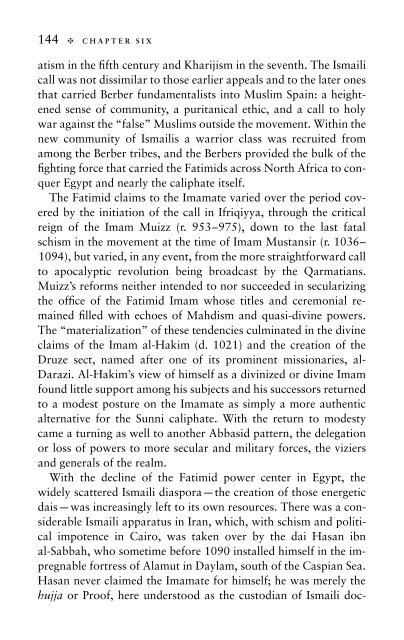Islam: A Guide for Jews and Christians - Electric Scotland
Islam: A Guide for Jews and Christians - Electric Scotland
Islam: A Guide for Jews and Christians - Electric Scotland
You also want an ePaper? Increase the reach of your titles
YUMPU automatically turns print PDFs into web optimized ePapers that Google loves.
144 t CHAPTER SIX<br />
atism in the fifth century <strong>and</strong> Kharijism in the seventh. The Ismaili<br />
call was not dissimilar to those earlier appeals <strong>and</strong> to the later ones<br />
that carried Berber fundamentalists into Muslim Spain: a heightened<br />
sense of community, a puritanical ethic, <strong>and</strong> a call to holy<br />
war against the “false” Muslims outside the movement. Within the<br />
new community of Ismailis a warrior class was recruited from<br />
among the Berber tribes, <strong>and</strong> the Berbers provided the bulk of the<br />
fighting <strong>for</strong>ce that carried the Fatimids across North Africa to conquer<br />
Egypt <strong>and</strong> nearly the caliphate itself.<br />
The Fatimid claims to the Imamate varied over the period covered<br />
by the initiation of the call in Ifriqiyya, through the critical<br />
reign of the Imam Muizz (r. 953–975), down to the last fatal<br />
schism in the movement at the time of Imam Mustansir (r. 1036–<br />
1094), but varied, in any event, from the more straight<strong>for</strong>ward call<br />
to apocalyptic revolution being broadcast by the Qarmatians.<br />
Muizz’s re<strong>for</strong>ms neither intended to nor succeeded in secularizing<br />
the office of the Fatimid Imam whose titles <strong>and</strong> ceremonial remained<br />
filled with echoes of Mahdism <strong>and</strong> quasi-divine powers.<br />
The “materialization” of these tendencies culminated in the divine<br />
claims of the Imam al-Hakim (d. 1021) <strong>and</strong> the creation of the<br />
Druze sect, named after one of its prominent missionaries, al-<br />
Darazi. Al-Hakim’s view of himself as a divinized or divine Imam<br />
found little support among his subjects <strong>and</strong> his successors returned<br />
to a modest posture on the Imamate as simply a more authentic<br />
alternative <strong>for</strong> the Sunni caliphate. With the return to modesty<br />
came a turning as well to another Abbasid pattern, the delegation<br />
or loss of powers to more secular <strong>and</strong> military <strong>for</strong>ces, the viziers<br />
<strong>and</strong> generals of the realm.<br />
With the decline of the Fatimid power center in Egypt, the<br />
widely scattered Ismaili diaspora—the creation of those energetic<br />
dais—was increasingly left to its own resources. There was a considerable<br />
Ismaili apparatus in Iran, which, with schism <strong>and</strong> political<br />
impotence in Cairo, was taken over by the dai Hasan ibn<br />
al-Sabbah, who sometime be<strong>for</strong>e 1090 installed himself in the impregnable<br />
<strong>for</strong>tress of Alamut in Daylam, south of the Caspian Sea.<br />
Hasan never claimed the Imamate <strong>for</strong> himself; he was merely the<br />
hujja or Proof, here understood as the custodian of Ismaili doc-
















